
Eye On
POULTRY OFFERINGS
Though Thanksgiving is the time to sit down to a bountiful repast, we’re afraid that this month’s selection of new home videogames doesn’t cut it. The major Christmas releases are announced, and as good as down the chimney. And, let’s face it—at least until home consoles are able to incorporate laserdisc technology and other innovations like Entertainment Software’s RIP process (see below), the action is going to be at the arcades.
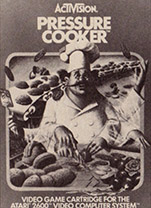
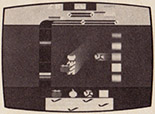
But we’re not sending you to bed hungry. Here are a few news morsels to carry you over till next month (and maybe till January, and the flood of releases expected at the Consumer Electronics Show in Las Vegas).
We hope you don’t get stuck with a turkey.
Pressure Cooker, to jump on a built-in segue, is Activision’s entry in the growing line of conveyor belt games. Short Order Sam must watch the electronic order board and assemble burgers with different combinations of lettuce, cheese, tomatoes, and onions. After finishing a burger, he carries it to the wrapping room, located on a separate screen.
Sam loses points for each mistake he makes—and, Activision assures us, he will make plenty as the game progresses and the orders mount up. ‘He gets pasted by tomatoes and goes head-to-head with lettuce. Onions roll. Cheese whizzes.” We hope he doesn’t burn his buns.
The game was designed by Gary Kitchen for the Atari 2600.
To continue in a culinary vein Activision has souped up the 2600 million-sellers River Raid and Kaboom! for the Atari 5200.
Says James Levy of Activision: “The enhanced graphics and play of these popular Activision hits and the arcade-like game features of the 5200 will heighten the action for sophisticated game players.” Both cartridges should be out in time for Christmas.
Coleco and MGM have signed a deal granting Coleco worldwide rights to the manufacture, promotion, and distribution of games based on the War Games motion picture. First up will be a ColecoVision cartridge, due before the end of 1983. The game contains multiple screens simulating those of the government computer featured in the film. It is the player’s job, as it was the job of the young computer genius in the film, to ward off impending nuclear war.
To finish on a downbeat: the three new Probe 2000 games displayed in this month’s Chip Ahoy section have (we’ve just discovered) been cancelled. That means Power Lords, Lord of the Dungeon, and Pursuit of the Pink Panther. War Room, announced along with the others, will see release. That one seemed to us the least promising of the lot, but we’ll have to assume that NAP knows what they’re doing.
SLICE OF LIFE
In these days of bombastic advertising claims (see our subscription ad this issue), it’s refreshing to find a product that lives up to its name. ShowBiz Pizza Place Inc. will shortly make its 150-plus fast food/entertainment outlets (see mention in this month’s Chuck E. Cheese feature) do exactly that. Not content with singing animals and dancing puppets, ShowBiz has finalized a deal to produce and screen movies in its restaurants, beginning by the end of this year in Dallas and Springfield, Missouri.
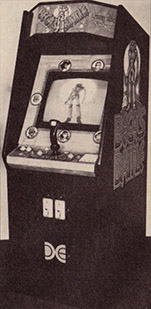
The nature of the movies is a news item in itself. Douglas Trumbull, partner in the venture, will be utilizing a process of his own invention called “Showscan.” He describes it as “the highspeed projection of 70mm film on a giant screen,” resulting in “dramatic realism, enhanced dimensionality, heightened clarity and brilliance, and a desired sense of involvement.” And probably a burgeoning popcorn concession at Show Biz.
The films will be produced by Trumbull’s Entertainment Effects Group, which did the special effects for MGM’s Brainstorm. The dimensional effects in that film were a prototype for the Showscan process.
YOU WATCH YOUR SCREEN—I’LL WATCH MINE
Showbiz’s movies had better be good—at least two recently announced arcade games feature graphics luscious enough to make players ignore Star Wars IV.
Following Dragon’s Lair into the laser disc game market—and doubtless preceding hundreds more entries—is Bega’s Battle. Data East USA, Inc. claims that their game surpasses Dragon’s Lair in giving the player “total control of the P.C.-generated characters with a level of playability not attained in the past.”
Based on an animated movie, the game follows Bega’s fight to save mankind through over forty different screens. His allies include Luna, who can bestow st,1per powers on ordinary humans; Sony (named after the Sony laserdisc machine inside the game?) who can teleport to the safety of other screens; Joe, who can activate a protective barrier; and the Indian, a turbaned strongman (shades of Punjab).
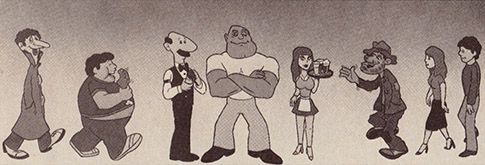
Once you’ve saved mankind, you can lower the stakes considerably with Bouncer. The object of the trackball-controlled title character is to eject undesirables, such as a drunk and a raincoated pervert, from four different drinking establishments. While doing this, you’ll knock over tables, chairs, and people, and break windows. If you clean out a bar and have at least one paying customer left, you move on to the next bar.
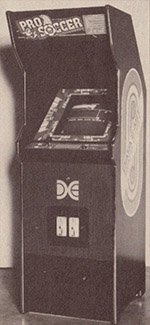
Entertainment Sciences used a one million byte-equipped real-time image processor (RIP), a hardware item of their own invention, to put Bouncer’s laserdisc like graphics on the screen. All seven main characters are fully animated on a 3D perspecitve play area. The game features a total of five hundred individual images (ten times what Entertainment Sciences claims is the arcade game norm) and a soundtrack with full speech and music.
Passing the ball back to the aforementioned Data East USA, Inc., they tout their new Pro Soccer as “the most interactive sports game ever offered.” Well—that’s bombast-free enough for us. Not the greatest, or the most exciting—just the most interactive.
Which may prove to be a justified claim. The player controls all eleven members of his/her team, with the option of forward, lateral, long, short, and centering passes, sliding tackles, dribbling, and goal shots. The joystick manipulates players in eight directions on a 30-view playfield.
In addition to taxing the gamer’s hand-eye skills, Pro Soccer tests his/her strategy-making ability as (s)he must put together goal-scoring forward maneuvers and defend against the opposing team’s challenges for the ball.
Also from DataEast comes Cluster Buster, which requires you to knock down piled-up items with a ricocheting ball. This is done with the joystick, aided by an angle change button. Pitfalls include holes in the ground and falling tarantulas
From the country that brought you all manner of deadly insects comes Espial, licensed out to Venture Line Inc. by Japan’s G.G.I. Corporation. The player must combat the air force of the alien world Espial, using laser cannons and radar-controlled missiles. In the beginning the going is easy, but it gets progressively tougher, climaxing in the arrival of Espial’s crack Green Angel Air Corps.
Venture Line has also signed on to manufacture and market Hunchback, a property of CVS Ltd. of England. With a joystick and jump button, the player guides Quasimodo as he attempts to rescue the princess Esmerelda.
IF YOU CAN’T BURY THE COMPETITION…
People haven’t exactly been lining up ten deep to buy Atari 2600 cartridges, and the price of many games has dropped to four or five dollars, as low as two dollars in some super closeouts. But no one ever suggested that Atari couldn’t give their games away.
Until Atari did.
An Alamorgordo, N.M. city landfill was recently graced with some of the most expensive refuse in history: fourteen truckloads of brand-new Atari game cartridges and hardware.
The games came from Atari’s El Paso plant, which has ceased the manufacture of videogames. Guards kept spectators out of viewing range as trucks buried the equipment in cement.
Reminds us of Steinbeck’s The Grapes of Wrath, in which the orange grove owners pour kerosene over their surplus fruit so the starving Okies can’t eat it. It might have been a nice gesture, especially this close to Christmans, to donate the unsaleable games to poor children. Many needy families own 2600s, especially now that they can be found for under $50 (and considerably less secondhand.)
Of course, Atari is hovering dangerously close to the poverty line themselves. And the cost of getting those games into worthy hands might have been prohibitive. But did Atari even look for a charitable organization that might handle the logistic? The Salvation Army, for example, or Toys for Tots? Both make free house calls in our neighborhood.
Atari says that, contrary to press accounts, the cartridges were defective, unsaleable, unusable. We’d prefer to believe that. Any other explanation gets us down in the dumps.
UNSELLIVISION
Mattel, Inc.’s latest press release reports a net loss of $156.1 million for the quarter ended July 30. (That’s one press release we’d have mailed without a stamp.) Mattel blamed the loss on its Electronics segment, and announced plans to cut future losses by reducing significantly the size of the operation, scaling back new product development, reducing sales expectations, and curtailing marketing of the Aquarius home computer.
The Aquarius will be marketed only internationally. It was test marketed in two midwestern cities, and presumably didn’t do well. Outside the USA, it will be up against less competition.
More gloom and doom: Activision, Inc. announced that, barring a sudden surge of orders, it will report a $3-5 million dollar loss for the current quarter.
And still more: Warner Communications, still reeling from the $310.5 second-quarter loss of its Atari division, has laid off one-third of its New York headquarters staff: 250 white collars. Atari’s problems are compounded at the moment by a pending $13.6 million class action suit, charging that the company illegally concealed a previous round of scheduled layoffs from its workers.
In capitalism as in evolution, only the strongest survive. And Mattel, Activision, and Atari will have to flex some pretty hard marketing muscle to gain back the ground they’ve lost to Coleco.
…AND A PLAYER TO BE NAMED LATER
First, the Phillies signed Pete Rose. Then, Don King signed Michael Jackson. And now The Games Network, Inc., has signed Broderbund, Inc., to a deal permitting them to use Broderbund’s games in their cable service (reported on in our August issue).
Broderbund games scheduled to be transmitted include Choplifter, David’s Midnight Magic, Seafox, Serpentine, Apple Panic, Load Runner, and A.E.
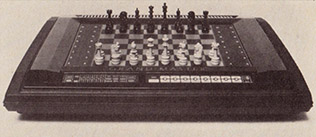
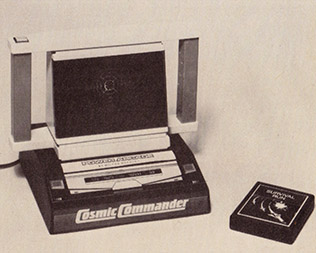
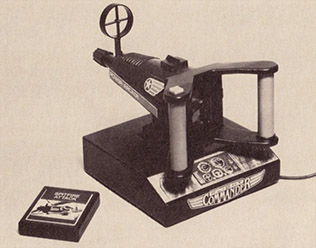
Other games makers signed to date include EduWare and Funtastic. Several others, a spokesperson said, have signed but have not yet been announced. (We happen to know that this latter group includes DataMost and Penguin.)
The Games Network is scheduled to go on-line in the first quarter of 1984—a much-revised projected date.
KNIGHT MOVES
Now the people who brought you the Game of Life have brought a game …to life. Brrr.
When you play Milton Bradley’s Grand-Master Chess Computer, you’ll feel like an invisible opponent is seated across the table. The computer physically moves pieces around the board, sliding those it captures off to the side. An “automatic replay” feature will reenact an entire game for analysis. If you opt for the “hint” function, the computer will wiggle that piece of yours that must be used to make your best possible move. A “take back” function lets you make trial moves, and the “intriguing problem mode” makes the computer find a.forced mate in a limited number of moves.
Gameplay is on twelve skill levels, from novice to expert. If the lowest is too hard or the highest too easy for you, you can make the computer play itself. Price will be under $500.
Also from Milton Bradley and less financially dear: Power Arcade, a line of peripherals compatible with the Atari 2600. The two models now being introduced, Flight Commander and Cosmic Commander, supposedly provide “unparalleled hands-on control and super-sensitive joystick response.”
While both consoles can be used with a wide variety of 2600 games, each is to be sold with an accompanying cartridge, for the price of the cartridge alone. (Whether or not that price will be a premium one remains to be seen.)
Flight Commander simulates a fighter plane cockpit, featuring a machine gun with barrel gunsight, firing button, and two-handed operation. Flashing control panels and vibrational feedback add to the effect. Accompanying cartridge is Spitfire Attack, a six-level dogfight/flak/anti-aircraft game.
Cosmic Commander resembles the console of a spacecraft (or so Milton Bradley tells us—how would we know?), also with flashing gauges and vibrational feedback. It comes with the five-level Survival Run, which leads players through a maze of tunnels to destroy an alien outpost.
LAPDOGS II
We would like to dispel the rather cavalier and dismissive impression we may have communicated in our October issue in regards to joystick anchor devices. Some of these devices are quite useful to the player who is tired of his or her 2600 joystick, wants to upgrade, but is either bewildered by, or can’t afford, a new deluxe joystick.
CBS Electronics’ Stick Station, for example, instantly turns the 2600 joystick into a deluxe stick with a solid base and a sturdy knob that fits over the top of the stick. Our scores climbed.

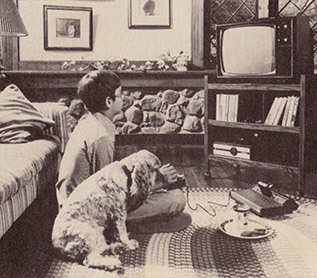
The knob makes all the difference; others, such as the Lap Board or the Stick Station (awfully large and ungainly) would greatly benefit from a similar addition.
DUES IN QUARTERS PLEASE
We’ve received word of two organizations addressing themselves to the interests of videogamers.
VIDION, a three thousand member group billing itself as the “international association of video game players,” offers a bimonthly newsletter, decal, and a variety of discounts for a $10 annual fee. A game exchange service is available for $3 per cartridge. Call (202) 328-9346 or write David Rice at 1440 N Street, N.W. Suite 601, Washington, D.C. 20005.
The Niagara Regional B.U.G. (Bally-users group) publishes a newsletter providing information on Astrocade and its supporting companies. Call (416) 688-4595 or write them at 6 Wooddale Drive, St. Catharines, Ontario, Canada L2T 1Y8.
COMPUTER CHIPPENDALES
When you finally give up trying to jam your video game/computer equipment onto/into your present television/stereo stand/desk/shelf, you may want to invest in furniture specially designed for your needs. The Gusdorf Company of St. Louis has just released such a line, ranging in price from $50 to $350. We can’t say how their line compares to others on the market—furniture is, after all, expensive to ship for review purposes—but it is appropriate, and available.
HOLD THAT GORILLA
New for ColecoVision: Add-a-Halt from Video Additions. It allows you to stop a game in the middle of play to answer the phone. Or rest your thumb. Or take out a ruler and measure the angle of incidence between your jet and the Zaxxonian fighter hovering above…
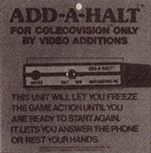
The toggle-switch controlled unit plugs into the Expansion Interface slot on the front of the ColecoVision module. Retail price is expected to be in the $19-$21 range, which could very well give some buyers pause.
ELECT TRON
Remember many issues back when we had the great who-wrote-the-Tron-sequel-and-passed-it-off-as-authentic mystery?
In case the matter has slipped your mind, this office received a manuscript, purportedly from Steven Lisberger, the director of the videogamesfilm Tron. The story was a sequel to that underrated gem.
Lisberger told us he didn’t write it, but now we know who did. It was literate Laura Ruskin of Whittier, CA. We know because she has come out of the cabinet and admitted that, as head of the fanclub Tron Fandom Forever, she wants to do everything possible to perpetuate our favorite video hero. “I want people who like Tron not to feel like they’re alone,” she recently told us.
For those interested in Tron, there is also another fan club, this one Friends of Tron. The difference, says Sheryl Adsit of the latter, is that her group “consists of fans of the film, not the Tron philosophy.” That philosophy, says Ruskin, is the theme frequently found in myth and legend that humans can bring new life to humankind by their actions against a god or authority figure.
Indeed, Ms. Adsit identifies so strongly with the film that she refuses to play videogames. “I hate getting derezzed,” she utters the Tron catchword. “I take it too personally.”
Information about both clubs can be had by writing to either lady c/o Box 1374, Hawthorne, CA 90250—incidentally, the hometown of Mattel Electronics.
SHORT TAKES
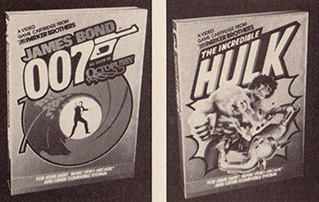
• Judging from the mail we’ve been receiving since we opened shop last year, the most eagerly awaited game ever is Parker Brothers’ Incredible Hulk for the 2600 and ColecoVision. Forget it, gang. Parker Brothers just announced that they are cancelling the game, along with the James Bond train-hopping 007 game.
We long ago gave up on that company’s projected Lord of the Rings game.
• A recent installment of Ripley’s Believe It Or Not made mention of a phototypesetting machine used in the orient. The United Daily News of Taipei, Taiwan has a keyboard that contains 10,000 characters and a capacity of 19,200 characters. Now those Occidentals who are having trouble learning to type can really feel stupid.
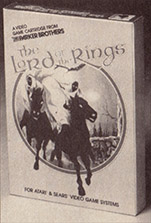
• On October 17th, the New York Times carried a story on their front page which proclaimed that the videogames industry is all but dead. The eulogy is obviously premature. There are far too many hardware units out there, and players actively using them, for committed companies to abandon them altogether.
But why go into all the pros and cons now? We’ll deal with the matter at length in the next issue.
• Videogame companies will do just about anything to promote their games. Fox Games sent editors ketchup and so on to promote Attack of the Killer Tomatoes. CBS Electronics sent us a pouch full of bogus diamonds to call attention to the release of Mountain King.
But recently, Activision went too far: their PR Firm (which is full of madwomen anyway) sent a Mad Bomber to the quivering and quaking VCI offices to promote the computer adaptation of Kaboom! No damage.
THE SERPENT
As our cover story this issue indicates, Coleco faces considerable marketing and technical difficulties with their Adam computer. Now, with the mid-October date for shipment of the first units approaching, the picture for Coleco has darkened even further.
In the second week of October, Coleco was hit by three lawsuits, filed in Federal District Court in Hartford, Connecticut, by Coleco stockholders. The complainants were seeking class action status on behalf of investors who purchased Coleco stock from late May to late September.
The suits charged that several Coleco officers, including president and chief executive officer Arnold Greenberg, sold $8 million of their Coleco stock in June, violating SEC rules by concealing unfavorable information about the computer while selling their stock at its peak.
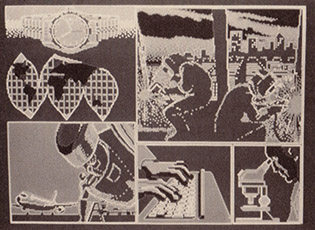
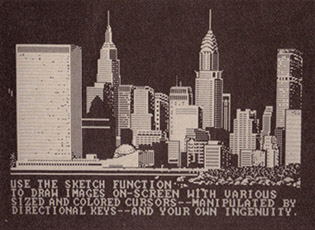
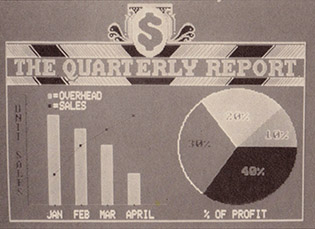
In June, Coleco stock was selling for $65 per share. As of early October, it was selling at less than half that amount.
Counsel for Coleco denied any wrongdoing, adding that all stock sales were reviewed by an outside law firm and were found to comply with SEC guidelines.
SHOOT AND SLIDE
This item, and the one following it, may be beyond the reach, financially, of most individual consumers now, but they point the way to products that wil be generally available in the next few years.
For the executive in a hurry (any other kind generally doesn’t last) a new graphics program will make it possible to create complete, integrated and impressive visual presentations in a matter of hours.
Created by Hoo-min D. Toong of VCN (Visual Communications Network, a division of Prentice Hall) in Cambridge, Massachusetts, VCN Execuvision is IBM-PC compatible. The menu-driven program comes complete with a full color “idiot proof” users manual; a demonstration disk; a library of hundreds of pre-rendered images from which to select; pie, bar and line graphics with a special automatic PLOT function; limited animation and motion techniques; sixty four color schemes and ten type styles; automatic run-time options; and complete sketch capabilities so that the user can create his or her own images.
All of the images on the included image menu and presentation disks can be trimmed, color-adapted and collaged as the user sees fit. Hard-copy slides can be created from the program with a camera (not included) that will lift images off the PC monitor, or a presentation paper can be printed out simultaneously. Little or no typing is required to create a presentation; the program is cursor-controlled.
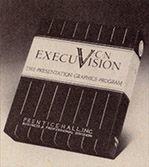
The program is divided into five functions, taking the user step-by-step through the processes of creating the images, putting the slides into the proper order, printing out slides or printer copy, running the show (on slides or on the PC monitor) and ending the show. The awarding of the contract and champagne quickly follow, of course, but are not guaranteed by Prentice Hall.
In addition to the images presented with the program, libraries of images will be available on disk for a hundred dollars each. The images include people, landscapes, tools, animals, maps, cityscapes, industrial representations…you name it. The program sells for $395.
As devised, Execuvision is useful mainly for business people; but consider the possibilities….
GIVE THEM A HAND
Consider this. You are the proverbial executive in a hurry (or professional writer or student); your express bus is stuck in traffic, but if you don’t arrive with a finished brief (or chapter or term paper) you will be fired (or failed). What do you do? Why, you whip out your Microwriter and finish the job enroute.
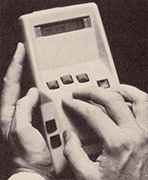
The Microwriter is a hand-held word processor. It has been available for the past year in Britain and the Netherlands from Microwriter Ltd. The Microwriter (We’ll tell you now, it sells for five hundred dollars.) contains only five keys, plus a function or command key, and allows the user to type all alphanumeric characters and punctuation and, with practice, do so at 150% of his/her handwriting speed.
The Microwriter weighs less than two pounds and is about the size of a trade paperback book. It uses rechargable batteries and contains 8K of non-volatile memory—good for about five pages of double spaced text. Portions of the typewritten information can be viewed on the self contained LCD display and the rest can be reviewed with ease. The unit boasts editing features such as review, delete, insert and formatting. Finished text can be transferred to a microcassette for further storage or (we knew you were wondering) the unit can be plugged into a printer to produce hard copy.
Microwriter Ltd., located in New York City, claims that most anyone can learn to microwrite in an hour. Amend that. Most young folk might; stodgy, clumsy adults will take a while longer. The principle is this:
The five keys are arranged to conform to the five fingers of the right hand at rest (left handers have no trouble using Microwriter, claims the company). Fingers do not jump from key to key; the letters and numbers are typed by simultaneously striking a number of keys. The striked keys roughly configure to the shape of the letter desired.
For example, the letter ‘I’ is typed with the index and thumb (straight up and down). To type an ‘R’ the index, thumb and middle (the top button, representing the top loop of the ‘R’) are used. For an ‘L’, it’s the index, thumb and little finger (the bottom key, the bar for the ‘L’). By visually imagining the letter to be typed, the user should be able to memorize the keys required. And with practice, it should eventually flow smoothly, reflexively.
If nothing else. the Microwriter could give life to a whole new way of diary writing. “Dear Diary: I am having lunch, I can see that nasty Mr. Blatts glaring at me from across the office. Oh no! He’s coming this way….”
STOCKING STUFFERS
As we see it, software will be ranked highly on many a Christmas list this year. So, for both the naughty and the nice, here is a round-up of some of the most recent releases.
Quicksilva Ltd., the British software publisher, has opened shop in San Antonio, Texas, with the object of extending their distribution arm through the U.S., Canada, and Latin America. While this move makes Quicksilva’s games more accessible to American Commodore 64, VIC-20, and Atari 400/800 owners, it is especially good news for Timex-Sinclair 1000/1500/2000 users, who suffer from a lack of available software.
Quicksilva’s latest releases include the following for the TS 2000: Xadom (battle your way through a 30 alien maze), Velnor’s Lair (sword and sorcery in the Goblin Labyrinth, lousy with demons, trolls, the undead, and the evil wizard Velnor), Smuggler’s Cove (fall through a concealed cave entrance into a historical fable of horror and Blackbeard’s treasure), 3D Strategy (fast-moving, nerve-racking game of noughts and crosses—tic-tac-toe for you Yank blighters), and Aquaplane (ski through marine maniacs, G&Ts, regattas, and a great white).
For the Commodore 64 from Screenplay:
Blackjack purports to teach you the techniques that won its designer five million dollars. (The obvious question is: why is he telling us?)
Asylum lets you use complete sentence commands to guide your character through 30 rooms and hallways, past wacky inmates and mysterious obstacles, to escape and save the world.
The Playful Professor demands correct answers to a series of math problems before he’ll let you escape from a ghostly castle. If you answer incorrectly, the professor explains your mistake.
Danger Ranger requires you to brave acid rain and fireballs to collect a treasure.
Pogo Joe bounces across a field of color-changing cylinders, pursued by the Mutated Wonderwhisk.
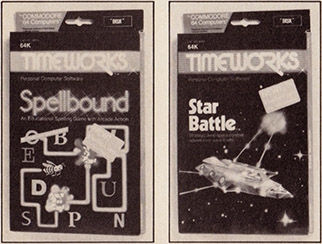
The Warrior of Ras series comprises four games, full of ghouls, goblins, traps, and hidden dangers, which change each time you play. In Dunzhin you elude the Wyverns to snatch treasure from the dungeon’s lowest level. In Kaiv, you descend into the bowels of the earth, sidestepping pools of acid and walking dead. Wylde takes you on a search for wealth in the wilderness. Ziggurat pits you against gruesome creatures in the maze. of the Mayan Pyramid.
The way Ras’ designers spell their game titles compels us to recommend Spellbound, an educational contest from Timeworks. The child must joystick-direct a bee around the screen, stringing together the letters of one of twenty words of the user’s choice. If the player strings the wrong letter or crosses his/her own path, the bee explodes. Surprise challenges provide bonus points.
Also from Timeworks: Star Battle, a strategy game that takes place in a three-dimensional galaxy with sixty-four quadrants. Weapons at your starship’s disposal in its struggle against the Scyons in elude warp and hyperlight driver, phasers, photon torpedoes and a tracking/viewing system, An overlay is included to change the 64 keyboard into OBNAC (Objective Based Navigation and Attack Computer) 3000.
Dropping down to the terran skies, you can learn to pilot a Piper 181 Cherokee Archer with Flight Simulator II from SubLOGIC. You get flight manual, full flight instrumentation (avionics included), navigation facilities, high-speed 3D view of the world outside your cockpit—all you need to practice takeoffs, landings, and aerobatics. Weather conditions are also adjustable. The four scenery areas—New York, Chicago, Seattle, and Los Angeles—include over eighty airports, with additional scenery areas available. When you think you’ve got the right stuff, you can earn your wings in the included World War I aerial battle game.
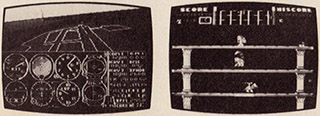
From Infocom: Enchanter, a interactive prose adventure. At the command of the Circle of Enchanters, you will explore an abandoned castle filled with strange magical artifacts and find spell scrolls which you must learn to use to overcome dozens of obstacles. Your overall goal is to learn enough magic to rid the kingdom of the evil and increasingly powerful warlock Krill. Included is a user’s manual and a sealed parchment from the Circle of Enchanters. Like Infocom’s other prose games, Enchanter uses the Interlogic programming system, offering a vocabulary of over six hundred words.
Just made available in C-64 format by Sirius: Wayout and Bandits, pictured and described in this month’s Chip Ahoy section. Soon to be made available in C-64 format by Broderbund: Drol, described below.
Available for the Apple are the following Avant-Garde releases: 5 Great Games includes Animal Bingo (line ‘em up in horizontal or vertical rows), Jungle Safari (blow ‘em to kingdom come), Space Defense (navigate past alien attackers, firing lasers and photon torpedoes), Sky Watch (guard the night skies against comets, UFOs, and enemy invasions), and Air Traffic Controller (direct runway approaches and landings of airplanes and helicopters-even foil a skyjacking or two). The five game disk is $29.95; each game purchased separately is $9.95 , except for Air Traffic Controller ($15.95).
When you tire of 5 Great Games, you can play—you guessed it—5 More Great Games, including Deep Sea Treasure (fend off a shark, an octopus, and a submarine to bring up sunken treasure), Mystery Code (use paddles to move around the screen deciphering), Depth Charge (pilot your PT boat through sub-infested seas), The Mine Fields of Normalcy (arrange symbols in a sequence on a mined board), and Turn ‘Em Loose (duck a rifle-wielding zookeeper while freeing the caged beasts). Again, the five-game disk is $29.95, with individual games going for $9.95 each.
Doctors who like to get in a few holes between incisions with Hi-Res Computer Golf can now play Hi-Res Computer Golf 2. Like its predecessor, it includes five courses of varying difficulty, with multi-screened fairways, contoured greens, trees, roughs, sandtraps, and watertraps. The player must choose the appropriate club and degree of swing, compensating for wind speed and other constantly changing factors. Added features include auto-swing options, scorecard archives processor, and tournament security option. The green fee is $29.95 for the original version, $34.95 for #2.
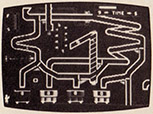
Broderbund’s Drol is exactly that: a game with such oddball obstacles as flying turkeys that turn to Thanksgiving roasts when shot, overweight monsters that hop around tossing lightning bolts, and witch doctors that throw magnets. You are equipped with a rocket backpack, laser gun, and wide-screen laser scope, your object being to rescue two children roaming under a witch doctor’s spell through scrolling underground corridors.
If that’s not silly enough for you, Broderbund’s got Gumball. As head sorter of the Sticky Sole Gumball Factory, you must contend with your boss who attempts to undo your work and dental assistants who try to blow up the factory with explosive gumballs. If you succeed, you get a promotion accompanied by a cartoon illustrating your new standard of living.
Both 48K cartridges are designed for the Apple II/II+/IIe.
From Learning Well, producers of some splendid educational games, come six new releases for the II/IIe.
New to their Early Childhood line of games, which are operated by the space bar only, are Knowing Numbers, Letters and Words, and Body Awareness. Each title features three different gaming activities which Learning Well promises are “fun, colorful, rewarding and comprehensive learning experiences.”
Space Math requires first to sixth graders to add, subtract, multiply and divide in order to shoot at Zorlyn spacecraft invading the earth.
Jungle Rescue Spelling; available for grades one to four or five to eight, has players use a helicopter to save monkeys from a fire. To do this, they must type the correct spelling of words, or make the proper multiple choice. Parent or teacher can enter his/her own word lists and view missed words.
That’s My Story provides young authors with story starters that set them on the path to writing creatively. At the end of each section, the student poses his/her own “What if?” questions for himself/herself or the next writer. It is also possible to make corrections or change stories.
Also available are the following games described above: Blackjack, Flight Simulator II (Apple II), Enchanter (Apple II), and Dunzhin in the Warrior of Ras series. Available soon for the Apple II will be Capture the Flag (described below).
For the Atari computers:
Spellunker from Micrographicimage, a graphics discovery game with over thirty screens. you must pass traps, barriers, ghosts of other explorers who lost their way, and other dangers to capture riches beyond imagination. Sure beats waiting for your IRAs to mature. On disk for the 400/800.
From Sirius, on disk, for the 800/1200: Capture the Flag. A split screen shows the player the area of the playfield (s)he occupies, along with a 30 view of the entire maze. The player must avoid capture by his/her opponent (the computer or another player) while searching for the exit. Tempo of the accompanying music tells how close the opponent is.
Also available for Atari are the above-mentioned Blackjack, Warrior of Ras, Asylum, Playful Professor, Danger Ranger, Pogo Joe, Space Math, Flight Simulator II, and Enchanter. Drol will shortly be available as well.
For the VIC-20:
Plasmania from Sirius, on cassette. See ths issue’s Chip Ahoy for depiction and description. Also just released in VIC-20 format by Sirius: Capture the Flag, described above.
For the IBM PC:
Blackjack, Dunzhin in the Warrior of Ras series, Asylum, and Enchanter (all described above).
For the TRS-80: The above-mentioned Enchanter.
SUMMER CAMPS, SUMMER NOT
While camps that teach children programming skills are nothing new, adult versions began sprouting up this past summer. Like the kids’ camps, most mix learning with outdoor activities over a one-or two-week period. The business-pleasure mix varies greatly from camp to camp, ranging from the bring-your-own-sleeping-bag seminar run by Atari founder Nolan Bushnell in the redwoods of California’s Scotts Valey to a $1995 Princess Cruise to Mazatlan, Puerto Vallarta, and Acapulco, with a grueling fifteen hours of classes spread out over the ten days.
While many of the camps do go heavy on the highballs, the concept is an excellent one-even more so for adults than
for kids. Adults don’t have the option of enrolling in eleventh grade computer math, and generally don’t have the time to learn programming on their own. And besides, everyone knows that grownups can’t learn this stuff as easily as kids can.
If Allan Sherman were still alive, he’d be singing next summer’s number one hit:
Hello Johnny,
Hello Sybil,
From your daddy
At Camp Nybble;
Everything is
User-friendly
And I’ll take whatever
money you can send me.
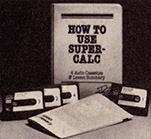
HIGH (TECH) FINANCE
Of course, you can be anti-social and do your learning at home. If it happens to be the SuperCalc spreadsheet program (compatible with the IBM PC and most CP/M-based machines) you want to master, FlipTrack Learning Systems of Glen Ellyn, IL has produced an audio lesson called How to Use SuperCalc.
The four tapes talk the user through the development of a cash flow budget, introducing him/her to all the commands and functions of SuperCalc. The FlipTrack format allows you to turn the cassettes over at key points for more indepth explanation and reinforcement. Price of the four cassettes, packaged in a vinyl album with an indexed lesson summary, is $75.00.
You’re on your own with Checkease! from T&F Software in North Hollywood, CA. The program allows Commodore 64, VIC-20, and Atari computer owners to maintain, edit, and reconcile records for one or more checking accounts. The program updates balance figures when you change or delete a deposit or withdrawal amount. Checks can be reviewed either by number or by category.
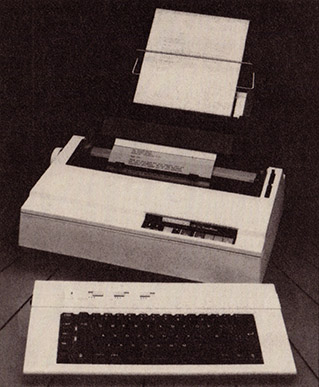
FLOWER POWER
Your first three checks can pay for the accessories now available from Comrex in Torrance, CA, that make their ComRiter CR-II daisy wheel printer capable of performing as a versatile word processor with most personal computers or as a stand-alone electronic typewriter. These accessories are lightweight keyboard ($199), cut-sheet feeder ($259), and tractor feed ($120). Price of the CR-II is $599. Also new from Comrex is a line of 5¼” diskettes. Model CR-10005 offers single-sided, single-density recording; CR-10010 single-sided, double-density; and CR-10015 double-sided, double-density. All carry a five-year guarantee. The premium model CR-10020 offers double-sided, double-density recording a lifetime guarantee.
APPLE A LA MODEM
Zoom Telephonies of Boston, MA is offering Apple II/IIe users a free permanent subscription to The Source, a well-known database, with purchase of its Networker for $129. The single-slot, 300-baud modem includes a diskette with required communications software.
The Source, accessible with a local phone call in five hundred major metropolitan areas, offers electronic mail and access to hundreds of boards, along with many business and financial databases, reservations and consumer services, and games.
PRETTY AS A PICTURE
If you own an Atari 800 computer and have three 16K boards, then here’s an item for you. Mosaic Electronics of Oregon City, Oregon has released the Mosaic Adapter, which is a device that will give your computer 48K and provide you with an open memory slot for other peripherals.
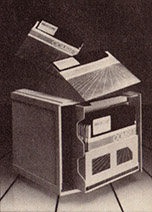
All you have to do is take the RAM chips off two of the Atari 16K Ram boards, and slip them into the open socket of the Mosaic Adapter. The folks at Mosaic have been thoughtful enough to provide picture guided instructions for ease in installation. The Mosaic 64K RAM SELECT or an 80 column board can be used in conjunction with the Mosaic Adapter.
ALL IN COLOR
New from Radio Shack are the following items:
• The Videotex Plus software packages (Models I/III and II/12/16) allow communication with computer information services of like protocol.
• Target Planner Calc is a new, $99.95 electronic spreadsheet that works with the TRS-80 Model 4, Model III and Model I.
• Also hot off the presses is the TP-10 Thermal Printer, for use with the TRS-80 Color Computer or Micro Color Computer Model MC-10. The TP-10 prints ninety-five characters plus sixteen block graphics characters, up to thirty-two per line, on 4 1/8” wide paper.
Source Pages











